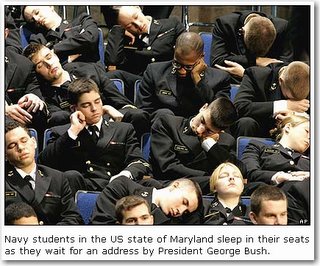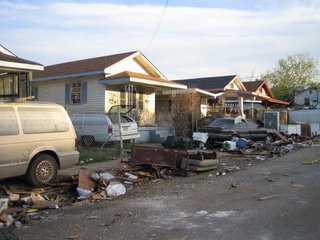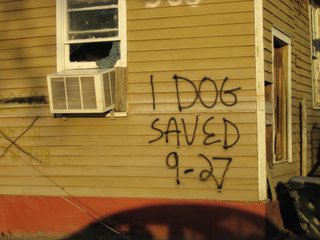
Today is absolutely today.
Today is not yesterday. Today is not tomorrow.
Miscellaneous travel notes by Steve White.
Wednesday, November 30, 2005
Waiting for George....
I don't know if this got covered anywhere else, but the BBC had a great picture of Navy students waiting to hear from their (and my) illustrious leader. It appears that they were a little more attentive when George was speaking.


Friday, November 18, 2005
The Shipping Forecast
I have just been reading a book on that strangest of all BBC Radio phenomenon - something that warms the heart of many a Brit of my generation – The Shipping Forecast. For the benefit of the American readers, the Shipping Forecast is a weather forecast for mariners that is broadcast four times a day on BBC radio (you can get it on the internet now too). While it’s intended audience was sea farers around the British Isles, it has become something much more than that and it is now equally important to many of us that have no connection with the sea at all - important not for its weather predictive capabilities, but for its comforting reassurance that all is still well in the United Kingdom (even though the weather may be foul).
The Shipping Forecast has been broadcast on the BBC since the 1930’s and it continues today even though a ship at sea must now have far better weather forecasting technology available to it. It is something I grew up with as did many of my generation and while I don’t really pay attention to the content, the words area almost poetic – “Thames, Dover, Wight – south westerly veering north westerly five or six, decreasing four. Rain then showers. Moderate with fog patches, becoming good”.
The book "Attention All Shipping" by Charlie Connolly is mainly a travelogue of the authors travels around the various sea areas in the Shipping Forecast, and I don’t know if I could recommend it, so to save you the trouble of reading it here is all you might ever need to know about the Shipping Forecast.
• It is produced by the Meteorological Office from a building in land-locked Bracknell of all places.
• The Met Office was created by Captain Fitzroy, who was the Captain of the Beagle for Darwin’s journey to the Galapagos (guess who else was on board – a scientist named Beaufort – the originator of the Beaufort Wind Scale).
• Fitzroy pioneered many of the early weather prediction methods and first coined the term “Weather Forecast”.
• The Forecast is a carefully crafted piece from 350 to 370 words long, read very precisely to fit into the allotted time slot on the radio.
• It is broadcast four times a day on Radio Four (00:48, 05:35, 12:01, 17:54) (it used to be on the Light Programme when I was a kid).
• There were originally 13 sea areas but now we have a total of 31 - check out the map.
• The forecast describes each area or group of areas in three sections – winds; weather; and visibility. For example, "Forties, Cromarty, Forth, Tyne, Dogger South veering southwest 4 or 5. Rain or showers. Moderate or good."
There was apparently much uproar in the UK when in 2002 the old sea area of Finisterre (off the north west coast of Portugal) was renamed Fitzroy in recognition of Captain Fitzroy’s contributions. People apparently got quite passionate about disrupting this age old tradition.
These days I take great comfort in hearing the Shipping Forecast on Radio Four over the Internet whilst I am comfortably tucked away in my house in California. I particularly like the 00:48 GMT broadcast where it is preceded with the music Sailing By (written by the British Composer and fellow Derbyshire resident Ronald Binge – what a name, and what absolutely awful light music).
The Shipping Forecast has been broadcast on the BBC since the 1930’s and it continues today even though a ship at sea must now have far better weather forecasting technology available to it. It is something I grew up with as did many of my generation and while I don’t really pay attention to the content, the words area almost poetic – “Thames, Dover, Wight – south westerly veering north westerly five or six, decreasing four. Rain then showers. Moderate with fog patches, becoming good”.
The book "Attention All Shipping" by Charlie Connolly is mainly a travelogue of the authors travels around the various sea areas in the Shipping Forecast, and I don’t know if I could recommend it, so to save you the trouble of reading it here is all you might ever need to know about the Shipping Forecast.
• It is produced by the Meteorological Office from a building in land-locked Bracknell of all places.
• The Met Office was created by Captain Fitzroy, who was the Captain of the Beagle for Darwin’s journey to the Galapagos (guess who else was on board – a scientist named Beaufort – the originator of the Beaufort Wind Scale).
• Fitzroy pioneered many of the early weather prediction methods and first coined the term “Weather Forecast”.
• The Forecast is a carefully crafted piece from 350 to 370 words long, read very precisely to fit into the allotted time slot on the radio.
• It is broadcast four times a day on Radio Four (00:48, 05:35, 12:01, 17:54) (it used to be on the Light Programme when I was a kid).
• There were originally 13 sea areas but now we have a total of 31 - check out the map.
• The forecast describes each area or group of areas in three sections – winds; weather; and visibility. For example, "Forties, Cromarty, Forth, Tyne, Dogger South veering southwest 4 or 5. Rain or showers. Moderate or good."
There was apparently much uproar in the UK when in 2002 the old sea area of Finisterre (off the north west coast of Portugal) was renamed Fitzroy in recognition of Captain Fitzroy’s contributions. People apparently got quite passionate about disrupting this age old tradition.
These days I take great comfort in hearing the Shipping Forecast on Radio Four over the Internet whilst I am comfortably tucked away in my house in California. I particularly like the 00:48 GMT broadcast where it is preceded with the music Sailing By (written by the British Composer and fellow Derbyshire resident Ronald Binge – what a name, and what absolutely awful light music).
New Orleans...

Another unexpected and short business trip this week - this time to New Orleans. My business was in Houma outside of New Orleans but I arrived early enough to take a quick drive into the city to see what the aftermath of Hurricane Katrina looked like.
The first thing you notice flying into New Orleans is the large number of blue roofed houses. FEMA have a blue roof program, which, as I understand it, provides a temporary blue plastic covering for damaged roofs on buildings that are going to be rehabilitated. There were a lot of blue roofs around the airport.
Driving into New Orleans, on the city streets rather than the freeway, there was dramatic evidence of what the storm and subsequent floods had done. Entire neighbourhoods devastated and for the most part deserted of people. Streets filled with all manner of debris – household, automobile and plant matter. Water and mud stained vehicles damaged beyond repair. Houses forsaken by their occupants each tagged with painted symbols denoting that they had been checked (presumably for human and animal contents). No businesses were open and no one was living there (as far as I could tell).
Moving out of the poorer neighbourhoods and into the downtown area there was more activity and signs of life but still nothing close to what you would call normal. In the French Quarter the damage didn’t look to be so bad, but there were very few people. I parked on Jackson Square with no difficulty (something you normally would never be able to do). I went to one of the few businesses open – the Café Du Monde for beignets and coffee. This is quite the tourist trap in normal times but that afternoon, the wait staff outnumbered the customers.
Traveling out the other side of the city to the east, the neighbourhoods became poorer again and the damage again became more significant. Block after block of debris strewn streets and deserted houses. Presumably these neighbourhoods will all be bulldozed – it just doesn’t look feasible to salvage any of them.
Strange, there was no smell. I expected to smell the rot and decay but that afternoon there was a strong breeze and the air smelled fresh.
I don’t know how you rebuild after something like that. There were many painted signs indicating that “the residents will be back and New Orleans will live on”. But whatever it becomes it won’t be the same. The French Quarter was already too much of a manufactured tourist experience for me. I can only imagine that it will get more so.
Here are some photos....





And of course, in the French Quarter, it doesn't look so bad.

Wednesday, November 09, 2005
My ride home...
This evening I was driving home and someone bumped into the back of me (in their car that is). It wasn’t anything too bad, but we both pulled over to the side of the road and got out. It was then that I saw the lady in the offending car was on her cell phone. The accident was apparently so inconsequential to her that she was still carrying on her phone conversation while we were stood outside our cars. I said that perhaps we should exchange information and she stopped talking long enough to give me her driver’s license (I am not sure she should have done that, but she did) and then she just continued on with her phone conversation.
Now I find that amazing on so many levels – that she should be as so impolite as to continue a conversation after being at fault in an accident, however minor, - that she should be so stupid as to let everyone know that she was perhaps not giving her full attention to driving the car at the time of the accident.
On inspection there was no real damage, at least not to my car, and so we continued on our way – me puzzled at what a strange and rude world this is, her probably just wondering who she can call next.
Now I find that amazing on so many levels – that she should be as so impolite as to continue a conversation after being at fault in an accident, however minor, - that she should be so stupid as to let everyone know that she was perhaps not giving her full attention to driving the car at the time of the accident.
On inspection there was no real damage, at least not to my car, and so we continued on our way – me puzzled at what a strange and rude world this is, her probably just wondering who she can call next.
Wednesday, November 02, 2005
The Holiday Season on 10th Avenue
It’s that time of year again when my neighbours across the street place inflatable dolls on their roof - a giant pumpkin for Halloween, a turkey for Thanksgiving and then a snowman for Christmas. It’s all quite unusual for our street which is normally quite unadorned even at Chrismas time. But a couple of years ago, some new folk arrived across the street, and they have this inflatable doll thing going on. I don’t know them at all (unusual in itself) and they seem quite reserved and private in every other way (I never see them talking to other neighbours on the street) and they don’t have children (so it’s not for the kids). Nevertheless, right on schedule, just before Halloween, the blow up pumpkin goes on the roof. The day after Halloween, the pumpkin is replaced by a turkey and then right after Thanksgiving we get the snowman.
I used to fantasize about getting a gun and shooting holes in them, but I realize they are those constantly inflating devices and you need a really big hole to deflate them – a shotgun might do it. But then I don’t have (and never will have) a gun so it’s just a fantasy. It’s probably not a good idea anyway.
Here are some photos.


Oh, I forgot to mention – at night they are illuminated!
I used to fantasize about getting a gun and shooting holes in them, but I realize they are those constantly inflating devices and you need a really big hole to deflate them – a shotgun might do it. But then I don’t have (and never will have) a gun so it’s just a fantasy. It’s probably not a good idea anyway.
Here are some photos.


Oh, I forgot to mention – at night they are illuminated!
Subscribe to:
Comments (Atom)